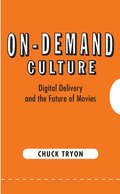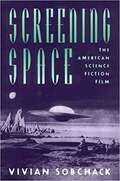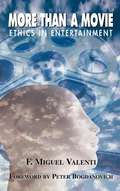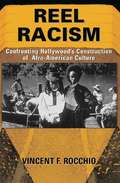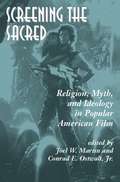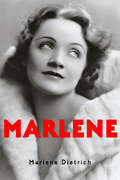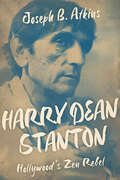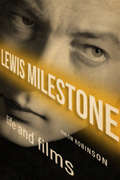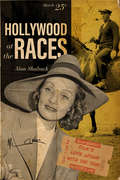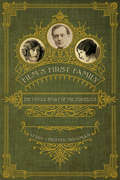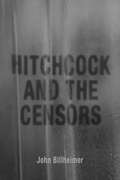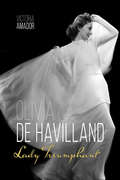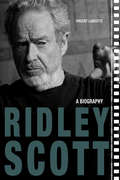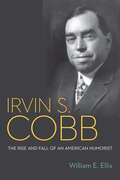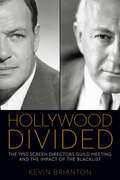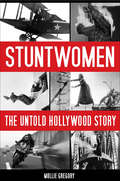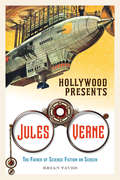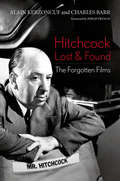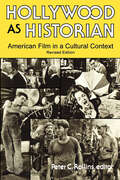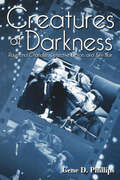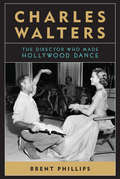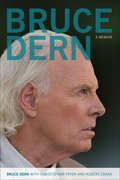- Table View
- List View
On-Demand Culture: Digital Delivery and the Future of Movies
by Chuck TryonThe movie industry is changing rapidly, due in part to the adoption of digital technologies. Distributors now send films to theaters electronically. Consumers can purchase or rent movies instantly online and then watch them on their high-definition televisions, their laptops, or even their cell phones. Meanwhile, social media technologies allow independent filmmakers to raise money and sell their movies directly to the public. All of these changes contribute to an "on-demand culture," a shift that is radically altering film culture and contributing to a much more personalized viewing experience.Chuck Tryon offers a compelling introduction to a world in which movies have become digital files. He navigates the complexities of digital delivery to show how new modes of access--online streaming services like YouTube or Netflix, digital downloads at iTunes, the popular Redbox DVD kiosks in grocery stores, and movie theaters offering digital projection of such 3-D movies as Avatar--are redefining how audiences obtain and consume motion picture entertainment. Tryon also tracks the reinvention of independent movies and film festivals by enterprising artists who have built their own fundraising and distribution models online. Unique in its focus on the effects of digital technologies on movie distribution, On-Demand Culture offers a corrective to address the rapid changes in the film industry now that movies are available at the click of a button.
Screening Space: The American Science Fiction Film
by Vivian SobchackThis text attempts to shape definitions of the American science fiction film, studying the connection between the films and social preconceptions. It covers many classic films and discusses their import, seeking to rescue the genre from the neglect of film theorists. The book should appeal to both film buff and fans of science fiction.
More Than A Movie: Ethics In Entertainment
by E. Miguel ValentiIn More Than a Movie, producer and entertainment attorney F. Miguel Valenti presents a compelling argument for the creative community to consider the consequences of its products, from movies to TV to the Internet. Valenti refrains from attacking the industries in which he himself works, but argues for reflection on the part of those who create media. More Than a Movie takes a pioneering first step toward outlining the issues in an insider fashion, and provides the tools to make ethical decisions about creating for the big and small screens. More Than a Movie is written to stimulate debate in professional and academic arenas, and for the enjoyment of everyone who loves entertainment.
Reel Racism
by Vincent F. RocchioReel Racism: Confronting Hollywood's Construction of Afro-American Culture goes beyond reflection theories of the media to examine cinema's active participation in the operations of racism --a complex process rooted in the dynamics of representation. Written for undergraduates and graduate students of film studies and philosophy, Reel Racism focuses on methods and frameworks that analyze films for their production of meaning and how those meanings participate in a broader process of justifying, naturalizing, or legitimizing difference, privilege, and violence based on race. In addition to analyzing how the process of racism is articulated in specific films, Reel Racism examines how specific meanings can resist their function of ideological containment, and instead, offer a perspective of a more collective, egalitarian social system-- one that transcends the discourse of race.
Reel Racism
by Vincent F. RocchioReel Racism: Confronting Hollywood's Construction of Afro-American Culture goes beyond reflection theories of the media to examine cinema's active participation in the operations of racism --a complex process rooted in the dynamics of representation. Written for undergraduates and graduate students of film studies and philosophy, Reel Racism focuses on methods and frameworks that analyze films for their production of meaning and how those meanings participate in a broader process of justifying, naturalizing, or legitimizing difference, privilege, and violence based on race. In addition to analyzing how the process of racism is articulated in specific films, Reel Racism examines how specific meanings can resist their function of ideological containment, and instead, offer a perspective of a more collective, egalitarian social system-- one that transcends the discourse of race.
Reel Racism
by Vincent F. RocchioFor undergraduates and graduate students of film and media studies and philosophy, an analysis of mainstream cinema's participation in societal racism. Rocchio (film studies, Dartmouth) analyzes how films produce meaning and how those meanings in turn lead to a broad process of justifying, naturalizing, or legitimizing difference, privilege, and violence based on race. The text grew out of a series of lectures Rocchio developed for a course on racism and representation at St. John's U. , Queens. Annotation c. Book News, Inc. , Portland, OR (booknews. com)
Reel Racism
by Vincent F. RocchioReel Racism: Confronting Hollywood's Construction of Afro-American Culture goes beyond reflection theories of the media to examine cinema's active participation in the operations of racism --a complex process rooted in the dynamics of representation. Written for undergraduates and graduate students of film studies and philosophy, Reel Racism focuses on methods and frameworks that analyze films for their production of meaning and how those meanings participate in a broader process of justifying, naturalizing, or legitimizing difference, privilege, and violence based on race. In addition to analyzing how the process of racism is articulated in specific films, Reel Racism examines how specific meanings can resist their function of ideological containment, and instead, offer a perspective of a more collective, egalitarian social system-- one that transcends the discourse of race.
Screening The Sacred
by Joel Martin Conrad E. Ostwalt Jr.What are the religious impulses in the 1976 film Rocky, and how can they work to shape one’s social identity? Do the films Alien and Aliens signify the reemergence of the earth goddess as a vital cultural power? What female archetypes, borne out of male desire, inform the experience of women in Nine and a Half Weeks?These are among the several compelling questions the authors of this volume consider as they explore the way popular American film relates to religion. Oddly, religion and film--two pervasive elements of American culture--have seldom been studied in connection with each other. In this first systematic exploration, the authors look beyond surface religious themes and imagery in film, discovering a deeper, implicit presence of religion. They employ theological, mythological, and social and political criticism to analyze the influence of religion, in all its rich variety and diversity, on popular film. Perhaps more importantly, they consider how the medium of film has helped influence and shape American religious culture, secular or otherwise. More than a random collection of essays, this volume brings to the study of religion and film a carefully constructed analytic framework that advances our understanding of both. Screening the Sacred provides fresh and welcome insight to film criticism; it also holds far-reaching relevance for the study of religion. Progressive in its approach, instructive in its analyses, this book is written for students, scholars, and other readers interested in religion, popular film, and the impact of each on American culture.
Marlene
by Marlene DietrichA fascinating self-portrait of one of the greatest entertainers of Hollywood&’s golden age Film star. Cabaret sensation. Recording artist. Writer. Marlene Dietrich was nothing short of enchanting—and remains so as she chronicles her fabulous rise to stardom in Marlene. From her early career in Germany as a chorus girl to her breakout role as Lola in The Blue Angel to her courageous wartime tours, Dietrich recounts a life that captivates on the page just as she smoldered on the screen. She writes passionately of her friends—including Charlie Chaplin, Orson Welles, and Edith Piaf, among many others—and she shares memories of what she calls her greatest accomplishment: entertaining the Allied troops during World War II. A sustained expression of her bold, sophisticated style, Marlene reminds us why Dietrich remains an international icon and a true Hollywood legend.
Harry Dean Stanton: Hollywood's Zen Rebel (Screen Classics Ser.)
by Joseph B. AtkinsHarry Dean Stanton (1926–2017) got his start in Hollywood in TV productions such as Zane Grey Theater and Gunsmoke. After a series of minor parts in forgettable westerns, he gradually began to get film roles that showcased his laid-back acting style, appe
Lewis Milestone: Life and Films (Screen Classics)
by Harlow RobinsonA biography of the Oscar-winning director and a study of his acclaimed films, like All Quiet on the Western Front, The Front Page, and Of Mice and Men.This comprehensive biography is the first to present Lewis Milestone’s remarkable life?a classic rags-to-riches American narrative?in full and explores his many acclaimed films from the silent to the sound era. Creator of All Quiet on the Western Front, Of Mice and Men, the original Ocean’s Eleven and Mutiny on the Bounty, Lewis Milestone (1895-1980) was one of the most significant, prolific, and influential directors of our time. A serious artist who believed in film’s power not only to entertain, but also to convey messages of social importance, Milestone was known as a man of principle in an industry not always known for an abundance of virtue.Born in Ukraine, Milestone came to America as a tough, resourceful Russian-speaking teenager and learned about film by editing footage from the front as a member of the Signal Corps of the US Army during World War I. During the course of his film career, which spanned more than 40 years, Milestone developed intense personal and professional relationships with such major Hollywood figures as Howard Hughes, Kirk Douglas, Marlene Dietrich, and Marlon Brando. Addressed are Milestone’s successes?he garnered 28 Academy Award nominations?as well as his challenges. Using newly available archival material, this work also examines Milestone’s experience during the Hollywood Blacklist period, when he was one of the first prominent Hollywood figures to fall under suspicion for his alleged Communist sympathies.Praise for Lewis Milestone“This highly readable biography of Lewis Milestone delivers the definitive study of a leading Jewish émigré director in Hollywood from the 1920s to the 1960s who worked successfully across multiple genres. Robinson seamlessly layers the scholarly expertise of a noted film historian of Russia and the Soviet Union with a novelist’s gift for narrative power and dramatic flair, bringing long overdue attention to Milestone’s fascinating life and enduring artistic achievements.” —Catherine Portuges, University of Massachusetts Amherst“A welcome biography of a man whose films remain better known than his name . . . . Robinson concentrates on the key aspects of Milestone’s life and career, never getting bogged down in plot synopses or other minor issues. Rather than shoveling up endless rubble, he offers us the milestones of Milestone. Robinson’s story is as tight as most classic Hollywood films, and that deserves to be heralded. This is a book equally as valuable to film buffs as to academic scholars, speaking to readers inside and outside the academy.” —LA Review of Books
Hollywood at the Races: Film's Love Affair with the Turf
by Alan Shuback“An informative and amusing look at the close relationship between Golden Age Hollywood and West Coast horse racing. A fascinating read.” —Christina Rice, author of Mean . . . Moody . . . Magnificent!Horse racing was so popular and influential between 1930 and 1960 that nearly 150 racing themed films were released, including A Day at the Races, Thoroughbreds Don’t Cry, and National Velvet.This fast-paced, gossipy history explores the relationship between the Hollywood film industry, the horse racing industry, and the extraordinary participation of producers, directors, and actors in the Sport of Kings. Alan Shuback details how all three of Southern California’s major racetracks were founded by Hollywood luminaries: Hal Roach was cofounder of Santa Anita Park, Bing Crosby founded Del Mar with help from Pat O’Brien, and Jack and Harry Warner founded Hollywood Park with help from dozens of people in the film community.The races also provided a social and sporting outlet for the film community—studios encouraged film stars to spend a day at the races, especially when a new film was being released. The stars’ presence at the track generated a bevy of attention from eager photographers and movie columnists, as well as free publicity for their new films. Moreover, Louis B. Mayer, Bing Crosby, Fred Astaire, Betty Grable, and Don Ameche were all major Thoroughbred owners, while Mickey Rooney, Chico Marx, and John Huston were notorious for their unsuccessful forays to the betting windows.“The more entertaining vignettes pair the names of old-time screen stars with ribald tales of racetrack depravity.” —Thoroughbred Daily News
Film's First Family: The Untold Story of the Costellos (Screen Classics)
by Terry Chester ShulmanScandal, adultery, secret marriages, celebrity, divorce, custody battles, suicide attempts, and alcoholism -- the trials and tribulations of the Costellos were as riveting as any Hollywood feature film. Written with unprecedented access to the family's personal documents and artifacts -- and interviews with several family members, including Dolores Barrymore Bedell (the daughter of John Barrymore and Dolores Costello) and Helene's daughter Deirdre -- this riveting study explores the dramatic history of the Costellos and their extraordinary significance to the stage and screen.This eccentric, tragic, yet talented clan was one of the twentieth century's most accomplished families of actors -- second only to the Barrymores, with whom they intermarried and begat a film dynasty riddled with jealousy, resentment, and heartbreak. Inevitably, the Costellos' brilliant achievements would be eclipsed by their own immutable penchant for self-destruction. Patriarch Maurice "Dimples" Costello (1877--1950) was considered the first screen idol and the first great movie star until his screen career, marked by accusations of spousal abuse, drunkenness, and physical assault, abruptly ended. His daughter Dolores married John Barrymore, arguably the most famous man in Hollywood during the late 1920s and early '30s, and their son would carry on the Barrymore name to successive generations of famous actors. Costello's other daughter, Helene, was the first actress to star in an all-talking picture, The Lights of New York (1928). However, her career was wracked by scandal in 1932 during her very public divorce from actor-director Lowell Sherman, who testified that his wife was a drunk and an avid reader of pornography. The original members of this pioneering family may be gone, but the name and legacy of the Costellos will live on through their accomplishments, films, and descendants -- most notably, actress Drew Barrymore.
Hitchcock and the Censors (Screen Classics)
by John BillheimerThroughout his career, Alfred Hitchcock had to deal with a wide variety of censors attuned to the slightest suggestion of sexual innuendo, undue violence, toilet humor, religious disrespect, and all forms of indecency, real or imagined. From 1934 to 1968, the Motion Picture Production Code Office controlled the content and final cut on all films made and distributed in the United States. Code officials protected sensitive ears from standard four-letter words, as well as a few five-letter words like tramp and six-letter words like cripes. They also scrubbed "excessively lustful" kissing from the screen and ensured that no criminal went unpunished.During their review of Hitchcock's films, the censors demanded an average of 22.5 changes, ranging from the mundane to the mind-boggling, on each of his American films. Code reviewers dictated the ending of Rebecca (1940), absolved Cary Grant of guilt in Suspicion (1941), edited Cole Porter's lyrics in Stage Fright (1950), decided which shades should be drawn in Rear Window (1954), and shortened the shower scene in Psycho (1960).In Hitchcock and the Censors, author John Billheimer traces the forces that led to the Production Code and describes Hitchcock's interactions with code officials on a film-by-film basis as he fought to protect his creations, bargaining with code reviewers and sidestepping censorship to produce a lifetime of memorable films. Despite the often-arbitrary decisions of the code board, Hitchcock still managed to push the boundaries of sex and violence permitted in films by charming -- and occasionally tricking -- the censors and by swapping off bits of dialogue, plot points, and individual shots (some of which had been deliberately inserted as trading chips) to protect cherished scenes and images. By examining Hitchcock's priorities in dealing with the censors, this work highlights the director's theories of suspense as well as his magician-like touch when negotiating with code officials.
Olivia de Havilland: Lady Triumphant (Screen Classics)
by Victoria AmadorLegendary actress and two-time Academy Award winner Olivia de Havilland is best known for her role as Melanie Wilkes in Gone with the Wind (1939). She often inhabited characters who were delicate, elegant, and refined. At the same time, she was a survivor with a fierce desire to direct her own destiny on and off the screen. She fought and won a lawsuit against Warner Bros. over a contract dispute that changed the studio contract system forever. She is also noted for her long feud with her fellow actress and sister Joan Fontaine -- a feud that lasted from 1975 until Fontaine's death in 2013.Victoria Amador utilizes extensive interviews and forty years of personal correspondence with de Havilland to present an in-depth look at the life and career of this celebrated actress . Amador begins with de Havilland's early life -- she was born in Japan in 1916 to affluent British parents who had aspirations of success and fortune in faraway countries -- and her theatrical ambitions at a young age. The book then follows her career as she skyrocketed to star status, becoming one of the most well-known starlets in Tinseltown. Readers are given an inside look at her love affairs with iconic cinema figures such as James Stewart and John Huston, and her onscreen partnership with Errol Flynn, with whom she starred in The Adventures of Robin Hood (1938) and Dodge City (1939 ). After she moved to Europe in the mid-1950s, de Havilland became the first woman to serve as the president of the Cannes Film Festival in 1965, and remained active but selective in film and television until 1988.Olivia de Havilland: Lady Triumphant is a tribute to one of Hollywood's greatest legends, who has evolved from a gentle heroine to a strong-willed, respected, and admired artist.
Ridley Scott: A Biography (Screen Classics)
by Vincent LoBruttoA study of the iconic and influential film director’s life and work, from the author of Stanley Kubrick: A Biography.With celebrated works such as Alien, Blade Runner, Thelma & Louise, and Gladiator, Ridley Scott has secured his place in Hollywood. This legendary director and filmmaker has had an undeniable influence on art and the culture of filmmaking, but is also a respected media businessman.In Ridley Scott: A Biography, Vincent LoBrutto delves into Ridley Scott’s oeuvre in a way that allows readers to understand the yin and yang of his exceptional career, offering a unique crosscut between the biographical facts of Scott’s personal life—his birth and early days in northeast England, his life in New York City—and his career in Hollywood as a director and producer of television commercials, TV series, miniseries, and feature films.Every film is presented, analyzed, and probed for a greater understanding of the visionary, his personality, and his thought process, for a deeper perception of his astounding work and accomplishments. The voices of cast and crew who have worked with Ridley Scott, as well as the words of the man himself, are woven throughout this book for a fully realized, critical biography, revealing the depth of the artist and his achievements.
Irvin S. Cobb: The Rise and Fall of an American Humorist
by William E. Ellis"Humor is merely tragedy standing on its head with its pants torn."—Irvin S. Cobb Born and raised in Paducah, Kentucky, humorist Irvin S. Cobb (1876–1944) rose from humble beginnings to become one of the early twentieth century's most celebrated writers.
Hollywood Divided: The 1950 Screen Directors Guild Meeting and the Impact of the Blacklist (Screen Classics)
by Kevin Brianton“Brianton’s well-documented study of a Hollywood controversy delves into one example of the post-WWII Red Scare” (Publishers Weekly).On October 22, 1950, the Screen Directors Guild (SDG) gathered for a meeting at the opulent Beverly Hills Hotel. Among the group’s leaders were some of the most powerful men in Hollywood—John Ford, Cecil B. DeMille, Joseph L. Mankiewicz, John Huston, Frank Capra, William Wyler, and Rouben Mamoulian—and the issue on the table was nothing less than a vote to dismiss Mankiewicz as the guild’s president after he opposed an anticommunist loyalty oath that could have expanded the blacklist. The dramatic events of that evening have become mythic, and the legend has overshadowed the more complex realities of this crucial moment in Hollywood history.In Hollywood Divided, Kevin Brianton explores the myths associated with the famous meeting and the real events that they often obscure. He analyzes the lead-up to that fateful summit, examining the pressure exerted by the House Un-American Activities Committee. Brianton reveals the internal politics of the SDG, its initial hostile response to the HUAC investigations, the conservative reprisal, and the influence of the oath on the guild and the film industry as a whole. Hollywood Divided also assesses the impact of the historical coverage of the meeting on the reputation of the three key players in the drama.Brianton’s study is a provocative and revealing revisionist history of the SDG’s 1950 meeting and its lasting repercussions on the film industry as well as the careers of those who participated. Hollywood Divided illuminates how both the press's and the public's penchant for the “exciting story” have perpetuated fabrications and inaccurate representations of a turning point for the film industry.Huffington Post Best Film Books of 2016Praise for Hollywood Divided“An authoritative reassessment of the meetings held by the Screen Directors Guild in 1950 to consider the adoption of a loyalty oath. Brianton traces the implications for the film industry and the reputations of key filmmakers, including Cecil DeMille and John Ford. He also offers sharp and illuminating reflections on the making of Hollywood history and myth.” —Brian Neve, author of The Many Lives of Cy Endfield: Film Noir, the Blacklist and Zulu“A breakthrough book on a topic that historians, for the most part, have considered settled. Brianton’s landmark study is fresh, thorough, and balanced, a model of Hollywood historiography. In clear prose, he takes the reader through the detailed twists and turns that created both the myth and the subsequent legend of the fateful Directors Guild Meeting that occurred during a critical time in American history.” —James D’Arc, Curator, Cecil B. DeMille Papers, Brigham Young University
Stuntwomen: The Untold Hollywood Story (Screen Classics)
by Mollie Gregory“Gives voice to the women who have risked their lives for a few (perilous) moments on the big screen. A fascinating look at a risky profession.” —The Washington PostThey’ve traded punches in knockdown brawls, crashed biplanes through barns, and raced to the rescue in fast cars. They add suspense and drama to the story, portraying the swimmer stalked by the menacing shark, the heroine dangling twenty feet below a soaring hot air balloon, or the woman leaping nine feet over a wall to escape a dog attack. Only an expert can make such feats of daring look easy, and stuntwomen with the skills to perform—and survive—great moments of action in movies have been hitting their mark in Hollywood since the beginning of film.Here, Mollie Gregory presents the first history of stuntwomen in the film industry from the silent era to the twenty-first century. In the early years of motion pictures, women were highly involved in all aspects of film production, but they were marginalized as movies became popular, and more important, profitable. Capable stuntwomen were replaced by men in wigs, and very few worked between the 1930s and 1960s. As late as the 1990s, men wore wigs and women’s clothes to double as actresses, and were even “painted down” for some performances, while men and women of color were regularly denied stunt work.For decades, stuntwomen have faced institutional discrimination, unequal pay, and sexual harassment even as they jumped from speeding trains and raced horse-drawn carriages away from burning buildings. Featuring sixty-five interviews, Stuntwomen showcases the absorbing stories and uncommon courage of women who make their living planning and performing action-packed sequences that keep viewers’ hearts racing.
Hollywood Presents Jules Verne: The Father of Science Fiction on Screen (Screen Classics)
by Brian TavesEven for those who have never read Jules Verne (1828--1905), the author's very name conjures visions of the submarine in Twenty Thousand Leagues Under the Sea, the epic race in Around the World in Eighty Days, the spacecraft in From the Earth to the Moon, and the daring descent in Journey to the Center of the Earth. One of the most widely translated authors of all time, Verne has inspired filmmakers since the early silent period and continues to fascinate audiences more than one hundred years after his works were first published. His riveting plots and vivid descriptions easily transform into compelling scripts and dramatic visual compositions.In Hollywood Presents Jules Verne, Brian Taves investigates the indelible mark that the author has left on English-language cinema. Adaptations of Verne's tales have taken many forms -- early movie shorts, serials, feature films, miniseries, and television shows -- and have been produced as both animated and live-action films. Taves illuminates how, as these stories have been made and remade over the years, each new adaptation looks back not only to Verne's words but also to previous screen incarnations. He also examines how generations of actors have portrayed iconic characters such as Phileas Fogg and Captain Nemo, and how these figures are treated in pastiches such as Journey 2: The Mysterious Island (2012). Investigating the biggest box-office hits as well as lower-budget productions, this comprehensive study will appeal not only to fans of the writer's work but also to readers interested in the ever-changing relationship between literature, theater, and film.
Hitchcock Lost and Found: The Forgotten Films (Screen Classics)
by Charles Barr Alain KerzoncufKnown as the celebrated director of critical and commercial successes such as Psycho (1960) and The Birds (1963), Alfred Hitchcock is famous for his distinctive visual style and signature motifs. While recent books and articles discussing his life and work focus on the production and philosophy of his iconic Hollywood-era films like Notorious (1946) and Vertigo (1958), Hitchcock Lost and Found moves beyond these seminal works to explore forgotten, incomplete, lost, and recovered productions from all stages of his career, including his early years in Britain.Authors Alain Kerzoncuf and Charles Barr highlight Hitchcock's neglected works, including various films and television productions that supplement the critical attention already conferred on his feature films. They also explore the director's career during World War II, when he continued making high-profile features while also committing himself to a number of short war-effort projects on both sides of the Atlantic. Focusing on a range of forgotten but fascinating projects spanning five decades, Hitchcock Lost and Found offers a new, fuller perspective on the filmmaker's career and achievements.
Hollywood As Historian: American Film in a Cultural Context
by Peter C. RollinsMotion picture images have influenced the American mind since the earliest days of film, and many thoughtful people are becoming ever more concerned about that influence, as about the pervasive influence of television. In eras of economic instability and
Creatures of Darkness: Raymond Chandler, Detective Fiction, and Film Noir
by Gene D. PhillipsMore than any other writer, Raymond Chandler (1888-1959) is responsible for raising detective stories from the level of pulp fiction to literature. Chandler's hard-boiled private eye Philip Marlowe set the standard for rough, brooding heroes who managed t
Charles Walters: The Director Who Made Hollywood Dance (Screen Classics)
by Brent PhillipsFrom the trolley scene in Meet Me in St. Louis (1944) to Fred Astaire and Ginger Rogers's last dance on the silver screen ( The Barkleys of Broadway, 1949) to Judy Garland's timeless, tuxedo-clad performance of "Get Happy" ( Summer Stock, 1950), Charles Walters staged the iconic musical sequences of Hollywood's golden age. During his career, this Academy Award--nominated director and choreographer showcased the talents of stars such as Gene Kelly, Doris Day, Debbie Reynolds, and Frank Sinatra. However, despite his many critical and commercial triumphs, Walters's name often goes unrecognized today.In the first full-length biography of Walters, Brent Phillips chronicles the artist's career, from his days as a featured Broadway performer and protégé of theater legend Robert Alton to his successes at Metro-Goldwyn-Mayer. He takes readers behind the scenes of many of the studio's most beloved musicals, including Easter Parade (1948), Lili (1953), High Society (1956), and T he Unsinkable Molly Brown (1964). In addition, Phillips recounts Walters's associations with Lucille Ball, Joan Crawford, and Gloria Swanson, examines the director's uncredited work on several films, including the blockbuster Gigi (1958), and discusses his contributions to musical theater and American popular culture.This revealing book also considers Walters's personal life and explores how he navigated the industry as an openly gay man. Drawing on unpublished oral histories, correspondence, and new interviews, this biography offers an entertaining and important new look at an exciting era in Hollywood history.
Bruce Dern: A Memoir (Screen Classics)
by Bruce Dern Christopher Fryer Robert CraneThis memoir by the Academy Award nominee “proves that Dern off-screen is every bit as unpredictable, compelling and explosively honest as he is onscreen” (Newsday).One of Hollywood’s biggest personalities, Bruce Dern is not afraid to say what he thinks. He has left an indelible mark on numerous projects, from critically acclaimed films to made-for-TV movies and television series. His notable credits include The Great Gatsby, The 'Burbs, Monster, Django Unchained, and Nebraska, for which he won the Best Actor award at the 2013 Cannes Film Festival. He also earned Oscar nominations for Best Supporting Actor in Coming Home and for Best Actor in Nebraska.In Bruce Dern: A Memoir, Christopher Fryer and Robert Crane help the outspoken star frame the fascinating tale of his life in Hollywood. Dern details the challenges he faced as an artist in a cutthroat business, his struggle against typecasting, and his thoughts on and relationships with other famous figures, including Elia Kazan, Alfred Hitchcock, Jack Nicholson, Paul Newman, Bob Dylan, Matt Damon, Jane Fonda, John Wayne, and Tom Hanks. He also explores the impact of his fame on his family and discusses his unique relationship with his daughter, actress Laura Dern.Edgy and uncensored, this memoir—filled with “amusing, illuminating, and occasionally heartrending anecdotes” (Philadelphia Inquirer)—is a wild ride and an insider’s view of fifty years in the film industry.
